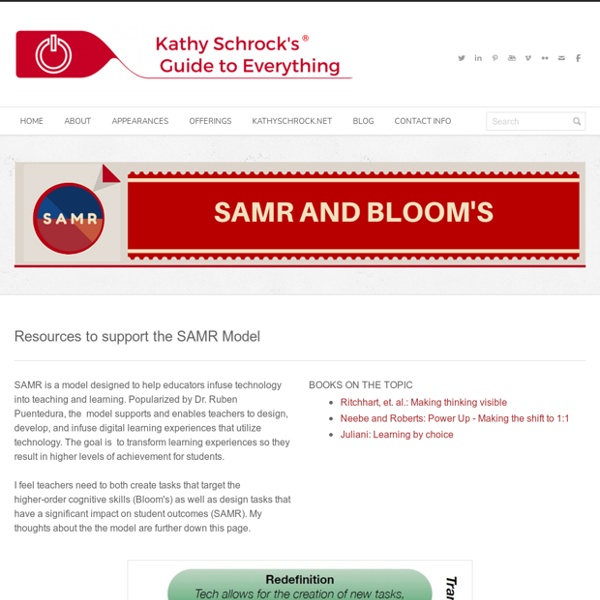



https://www.schrockguide.net/samr.html
Related: GENERAL • EDUC 540 • EDUC 540 • EDUC540Avoiding Plagiarism Tutorial <hr><p><b>You must have javascript enabled to view this website. Please change your browser preferences to enable javascript, and reload this page.</b></p><hr> Avoiding Plagiarism Tutorial To avoid plagiarism, adhere to these guidelines: General Format // Purdue Writing Lab Note: This page reflects the latest version of the APA Publication Manual (i.e., APA 7), which released in October 2019. The equivalent resource for the older APA 6 style can be found here. Please use the example at the bottom of this page to cite the Purdue OWL in APA. A Guide for Bringing the SAMR Model to iPads When used effectively, iPads can develop thinkers and problem solvers. They can be used to transform learning inside and outside of the classroom, and offer limitless opportunities. Many educators are effectively integrating technology in the classroom using iPads to achieve the 4C’s, or “super skills,” that digital learners need to compete in our global society.
The TPACK Framework Explained (With Classroom Examples) TPACK is a technology integration framework that identifies three types of knowledge instructors need to combine for successful edtech integration—technological, pedagogical, and content knowledge (a.k.a. TPACK). While TPACK is often compared with the SAMR Model, they are very different in scope. Later, we'll take a look at the differences of these frameworks in more depth. But to quickly give you a little context, the SAMR Model is really designed to provide a high-level gauge of the degree of technology use, but some consider it to be overly simple and somewhat confusing. The TPACK framework, on the other hand, provides more of a map for understanding how to integrate technology into the classroom effectively.
What Can Studying the Book of James Teach Us About Faith? The Book of James is filled with practical wisdom for Christians, calling us to live out genuine faith through good works. In our own ability, we cannot stand in the face of adversity. Without faith we could never find the strength to trust God. We would never be able to see above the trials we meet and to keep our eyes focused on the King while counting our trials as joy. This is the essence of James. We don’t work to be saved; we work because we are saved.
Tech & Learning An incredible tool to think about the integration of technology with instruction was developed in 2010 by Ruben Puentedera when he introduced what we now know as the SAMR model. The acronym stands for Substitution, Augmentation, Modification, and Redefinition, and the intention was to create a shared language across multiple disciplines so that teachers would be able to determine the best use of technology as an instructional tool. Loui Lord Nelson and Andrew Churches inspired Kathy Schrock to create the image above of the model associating it with the levels of the new Bloom’s Digital Taxonomy. Many teachers successfully adopted the SAMR model to help them determine the best way to introduce a technology and scaffold learning to the redefinition level. In fact, the Technology Integration Matrix gives a nod to the model in the technology integration levels of the rubric. So, it begs the question, “Is SAMR a fatality of COVID?”
Tech & Learning Reader Favorites 6 Ways To Access YouTube Videos Even If They're Blocked at SchoolGet online videos from YouTube even when behind a restricted connection Top 10 Free Sites for Creating Digital ArtThese free digital art creation sites range from simple web apps for preschoolers to sophisticated software for advanced students, educators, and professionals. 5 Ways to Prevent Cheating on Your Google Form QuizGet a cheat-proof Google Form quiz for class using these top tips Awesome Articles for Students: Websites and Other ResourcesThese free current event and general interest articles can be used for researching a topic, staying informed on what's happening in the news, pleasure reading, and more. Updating Bloom’s Taxonomy for Digital LearningBloom’s Digital Taxonomy is a technology-friendly update of the classic framework
Educational Technology TPACK, shown below, is a useful model for educators as they begin to use digital tools and strategies to support teaching and learning. This model, developed by educational researchers Mishra and Kohler (2006), is designed around the idea that content (what you teach) and pedagogy (how you teach) must be the basis for any technology that you plan to use in your classroom to enhance learning. Diagram and explanation ©2012 by tpack.org. Reproduced by permission of the publisher. The circles in the TPACK diagram represent content knowledge, pedagogical knowledge, and technical knowledge. The areas where the circles overlap — where the three kinds of knowledge combine — can be explained as follows: Why do we need technology integration in education? - Classcraft Blog - Resource hub for schools and districts Technology in education mirrors the fast-paced world we live in. In modern classrooms, it’s rare to find students all working on the same exact activity. Instead, today’s schools are technology-rich learning spaces that promote diverse activity. They’re abuzz with collaboration, critical thinking, creativity, and communication, all thanks to technology. Ask an administrator about using technology in the workplace, and you might hear about edtech as a tool for going about the business of school.